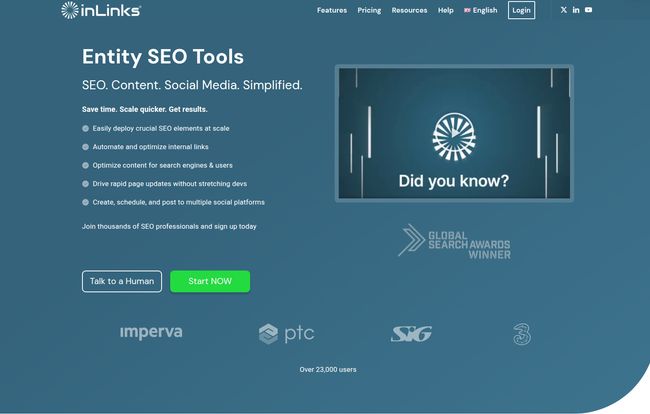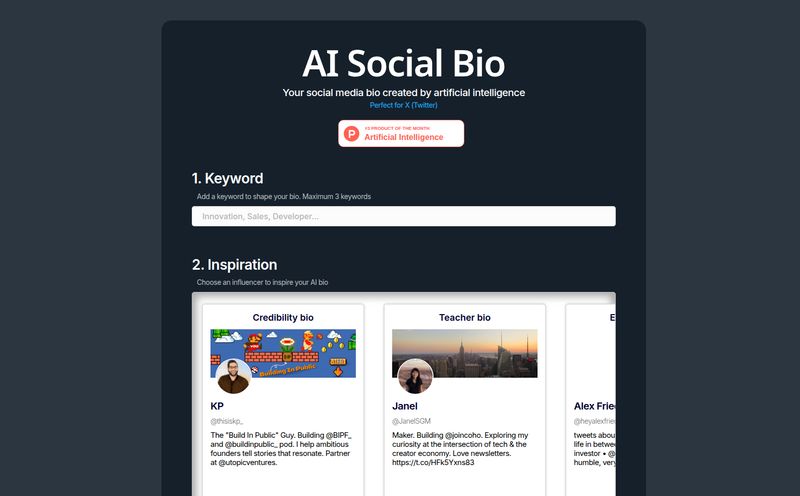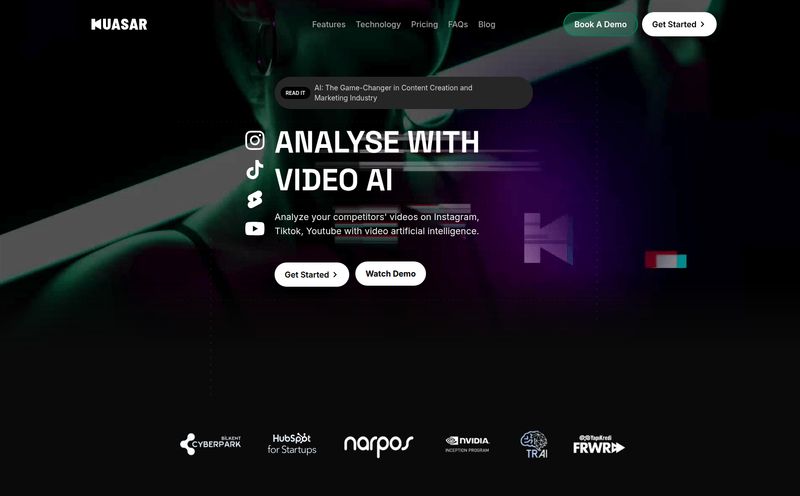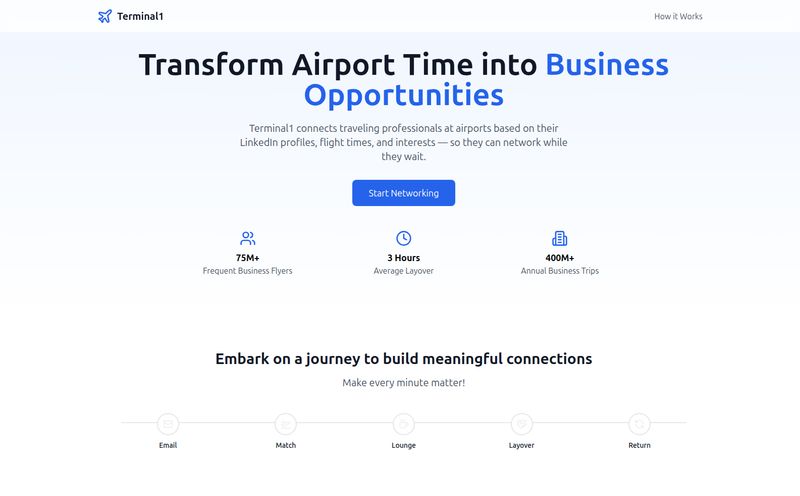If you've been in the SEO game for more than five minutes, you know the grind. The endless keyword lists, the mind-numbing task of internal linking, the constant battle to prove to Google that yes, your content is actually relevant. It’s a full-time job just keeping up. Sometimes, it feels like we're just throwing spaghetti at the SERP wall to see what sticks.
For years, we’ve been obsessed with keywords. But the ground has shifted beneath our feet. Google got smarter. A lot smarter. It's not just matching words anymore; it's understanding concepts, relationships, and context. This is the world of entity SEO, and if you’re not playing in it, you’re already falling behind.
I recently got my hands on a tool that claims to simplify this whole mess: InLinks. It's been making some noise, and I've seen some impressive case studies floating around (jumping from 45th to 5th in the SERPs? Color me intrigued). So, is it just another shiny object, or is it a genuine game-changer? Let’s get into it.

Visit InLinks
What's the Big Deal with Entity SEO, Anyway?
Before we go further, let's quickly demystify this "entity SEO" thing. In the simplest terms, an entity is any well-defined thing or concept: a person, a place, a brand, an idea. Think of it like this: if it has a Wikipedia page, it’s probably an entity.
Google’s goal is to understand these entities and the relationships between them, just like a human would. It’s building a massive web of knowledge called the Knowledge Graph. So, instead of just ranking a page for the keyword “best coffee grinder,” it's trying to understand the concepts of coffee, grinding, brewing methods, and popular brands. Your job is to show Google you understand this entire topic, not just one keyword. That's where entity SEO comes in, and frankly, it's where a lot of manual strategies fall apart.
A Closer Look at InLinks: More Than Just Another SEO Tool
InLinks pitches itself as an “Entity SEO Tool” that simplifies SEO, content, and social media. That's a tall order. From what I’ve seen, its real power lies in automating the most tedious and complex parts of modern SEO. It’s like having a junior SEO who is a genius at semantics and never needs a coffee break.
Automated Internal Linking That Actually Works
Okay, I’ll admit it. I despise manual internal linking. It’s critically important for site architecture and passing link equity, but it’s also painfully slow and easy to get wrong. InLinks automates this entire process. You install a snippet of JavaScript, and it analyzes your site's content to build an internal linking graph. It identifies relevant anchor text and automatically creates links between pages, helping to establish those all-important topic clusters. It even automates the creation of Schema markup, spoon-feeding Google the contextual information it craves. This alone is a massive time-saver, especially for larger sites.
The Topic Planner: Your New Content Strategy Brain
This feature got me pretty excited. Most keyword tools are… well, dumb. They give you a list of related terms and search volumes, but they lack context. They don’t know what you’ve already written about or what your audience actually needs.
The InLinks Topic Planner is different. It analyzes your entire website to see what topics you cover and, more importantly, where the gaps are. It suggests new pillar pages and supporting content to build out your topical authority. It's less like a keyword list and more like a strategic blueprint for content domination. It’s the difference between guessing what to write next and having a data-backed plan.
Content Optimization and Audits
It's not just about planning new content. What about the pages you already have? InLinks includes a content editor and audit tool that scores your existing pages against the entities and topics it has identified as important. It gives you concrete suggestions for improving relevance and depth, helping you squeeze more SEO juice out of the content you've already worked so hard to create. Seeing those case studies about jumping from 32K to 61K ranking keywords in a few months makes a lot more sense when you see this feature in action.
"InLinks is a game changer for semantic search optimization. InLinks has helped me better understand entities and how semantic search works. It's a must-have for any technical SEO worth their salt."
So, How Does InLinks Stack Up?
No tool is perfect, right? After playing around and kicking the tires, here’s my honest take. The big win is obviously the automation. Taking internal linking and schema off my plate is a dream. It genuinely simplifies the move towards an entity-first strategy, which is where the industry is heading. It saves a ton of time and mental energy.
On the flip side, the power comes at a cost. The pricing is page-based, so for massive websites, the bill can climb. Also, the full automation relies on JavaScript integration. It's not a huge technical hurdle, but it's something to be aware of if you're not comfortable adding code to your site. And like any powerful tool, there’s a bit of a learning curve to really master all its features. You have to be willing to spend some time to get the most out of it.
Let's Talk Money: InLinks Pricing Breakdown
Pricing is always a deciding factor. InLinks offers a few different tiers, which is nice to see. They even have a free plan, so you can try before you buy.
| Plan | Price | Best For |
|---|---|---|
| Free | Free | Small blogs or those wanting to test the waters. Limited to 25 pages for internal linking and 2 content optimizations a month. |
| Freelancer | Starts at $49/month | Solo SEOs, content managers, and small businesses. Covers 100 pages and unlocks the full Content Planner and AI features. |
| Agency | Starts at $196/month | Marketing agencies or in-house teams managing multiple projects. Starts with 430 pages and adds API access, unlimited users, and more. |
| Enterprise | Contact for Pricing | Large corporations with massive websites (100,000+ pages) needing dedicated support and infrastructure. |
Is InLinks Worth the Investment? My Honest Take
So, the million-dollar question: should you use InLinks?
In my experience, if you're an SEO professional, a content strategist, or an agency tired of the old keyword-stuffing playbook, then yes, absolutely. The time you'll save on manual tasks like internal linking and schema alone probably justifies the cost. But the real value is in the strategic shift it encourages—forcing you to think in terms of topics and entities, which is exactly how Google thinks.
If you're a total beginner or running a tiny personal blog with a handful of pages, it might be overkill. But for anyone serious about scaling their content and getting a competitive edge in the SERPs, InLinks feels less like a tool and more like an unfair advantage.
Frequently Asked Questions about InLinks
What exactly is InLinks?
InLinks is an SEO software platform focused on entity-based SEO. It helps automate difficult SEO tasks like internal linking and schema markup, provides advanced content planning tools based on topics, and helps you optimize your content to be better understood by search engines.
How does InLinks help with SEO?
It helps by automating internal linking to build strong topic clusters, generating schema markup to help Google understand your content, and providing a topic planner to identify content gaps. This combined approach is designed to improve your site's topical authority and, as a result, its search engine rankings.
Is there a free version of InLinks?
Yes, there is a free plan. It allows you to internally link up to 25 pages and perform two content optimizations per month. It's a great way to try out the core functionality before committing to a paid plan.
What is the difference between InLinks and other keyword tools?
Traditional keyword tools focus on individual keywords and search volume. InLinks' Topic Planner analyzes your entire site's context to suggest topic clusters and content gaps. It's a more holistic, strategic approach to content creation that aligns with how modern search engines work.
How much does InLinks cost?
InLinks pricing is tiered. It starts with a Free plan, the Freelancer plan starts at $49/month, the Agency plan starts at $196/month, and there's a custom Enterprise plan for very large sites. Pricing scales based on the number of pages you need to manage.
Do I need to be a developer to use InLinks?
No, not at all. While full automation requires adding a single line of JavaScript to your site (which is often easy to do with plugins or a tag manager), the content planning and optimization tools can be used without any coding knowledge.
Final Thoughts
The SEO world never sits still. The shift from simple keywords to complex entities is one of the biggest changes we've seen in a decade. Tools like InLinks aren't just about making our lives easier; they're about adapting to this new reality. By automating the technical stuff and providing a smarter way to plan content, it lets you focus on what really matters: creating great stuff that your audience loves. And at the end of the day, that’s what this is all about, isnt it?



